10 Aggressive Aquarium Fish
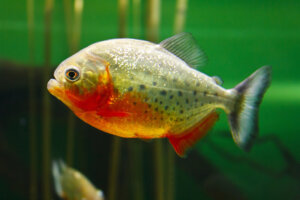

Written and verified by the biologist Cesar Paul Gonzalez Gonzalez
Aquariums are ideal for livening up our homes, and, even though they need continuous care, the bright colors of the specimens brighten up the room and the upkeep is always worth it. However, not all fish get along well inside the aquarium, as some tend to be more aggressive than others. Find out about 10 aggressive aquarium fish today.
It’s important to identify which species have the worst temperament. This way, conflicts are avoided and a calmer habitat is provided for all specimens. Read on to learn about 10 aggressive aquarium fish.
Why are fish aggressive?
In nature, fish don’t usually have enough food within their reach, and so they’re constantly searching for it. One of the most commonly used strategies is to monopolize a territory, since this means having more places to look for food. To protect their area of action, some fish have to be quite aggressive and chase away their competitors.
In this way, aggressiveness in fish is just a survival mechanism that allows them to grab resources. Violent behavior is also part of the life strategies of living beings, as it confers several advantages over other not so belligerent organisms.
Aggressive aquarium fish
Despite the fact that specimens live inside an aquarium, this doesn’t mean that they leave their wild instincts to one side. For this reason, some of them continue their aggressive behavior in the tank. This situation isn’t positive for the conditions of the tank, because, being a smaller space, the other members are easily stressed.
Here we’ll show you the most conflictive specimens in this type of environment.
1. African cichlids
One of the reasons for keeping an aquarium at home are the colors exhibited by the specimens. Therefore, it’s normal to look for fish such as African cichlids, as they have diverse and wonderful morphotypes. However, it’s better to be careful with them, as, apart from being very active organisms, some of them are territorial and quite aggressive.
This doesn’t mean that it’s impossible to have them in an aquarium, but it is difficult to find the ideal “aquarium mates”. In addition, it’s better if you provide them with a spacious habitat, so they can have more space to share with other fish. If their beauty has captivated you, consider that they aren’t compatible with the following types of fish.
- Angelfish
- Betta Fish
- Discus fish
- Goldfish
- Guppies
- Goldfish
- Rainbow fish
- Bubblefish
- Zebrafish
- Neon fish
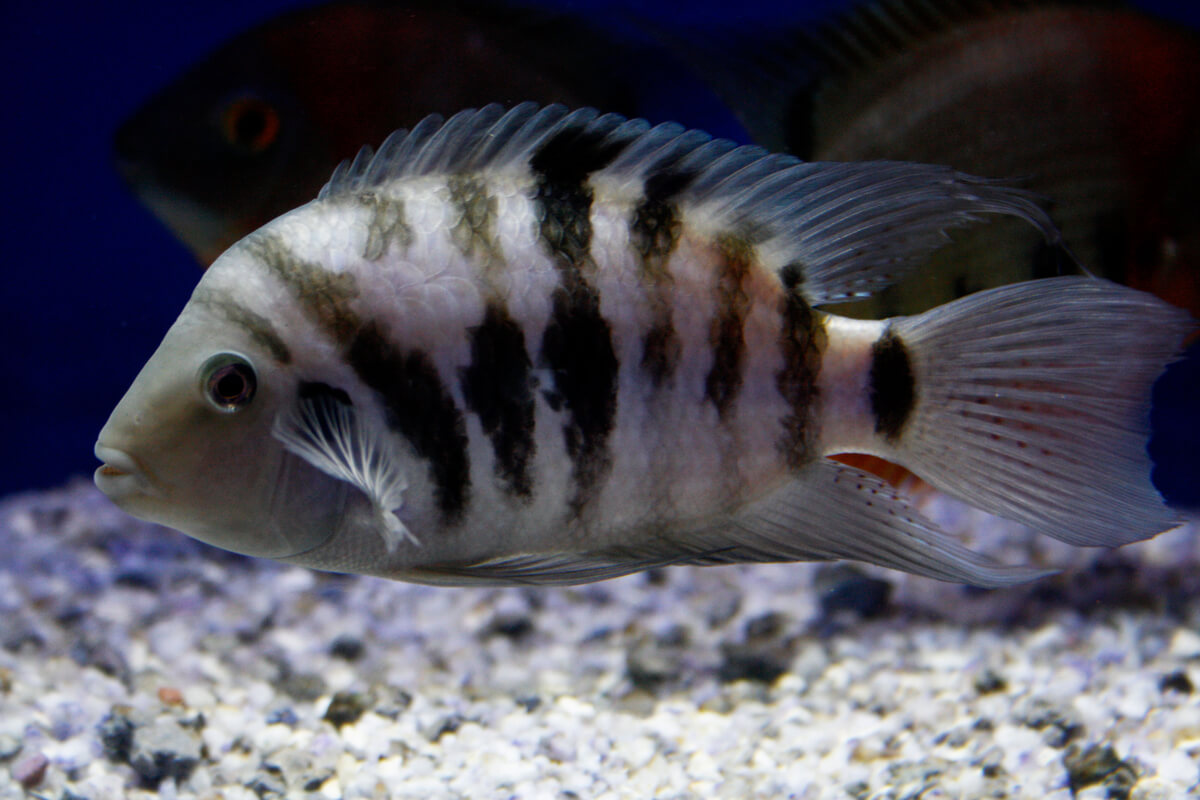
2. Tiger barb (Puntius tetrazona)
Apart from being beautiful, these are very active and aggressive fish, as they sometimes chase the calmer species. This doesn’t mean that they’re territorial, as they’re usually sociable and tolerant fish. However, when the size of the aquarium is very small or there are many individuals in the tank, this fish suffers stress and begins to behave aggressively.
In general, it isn’t recommended to keep the tiger barbel with other slower or shy species, as it can annoy and injure them. Try not to add in the aquarium fish that meet these characteristics, as they’ll be the main targets. Some specimens with which tiger barbels aren’t compatible are listed below.
- Betta fish
- Goldfish
- Guppy fish
- Angelfish
- Discus fish
If you want to reduce the aggressive behavior of these fish, include more of their species. This calms their activity a bit and they will feel calmer, as barbs are gregarious by nature. This only reduces the intensity of the situation a little, so it isn’t a measure to prevent them from harming or eating others in the tank.
Not all aggressive aquarium fish are big.
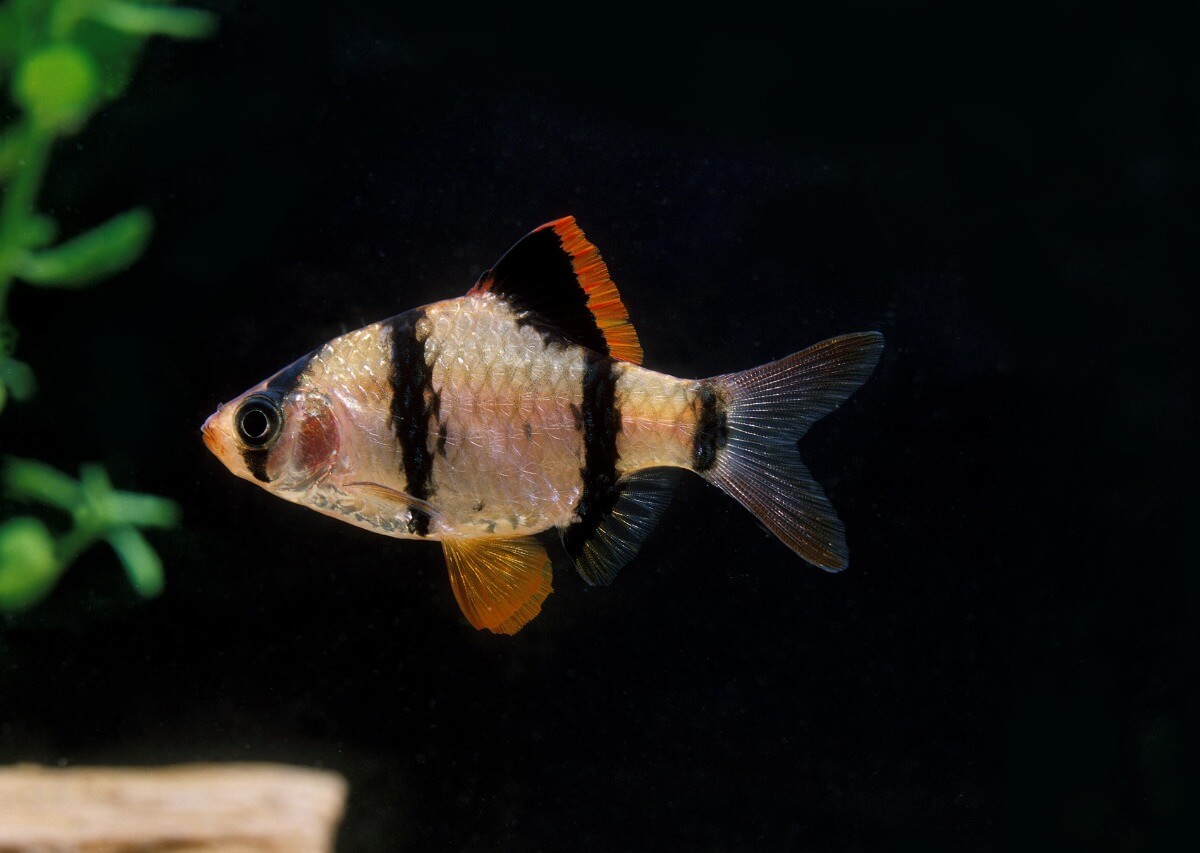
3. Oscar fish (Astronotus ocellatus)
Despite the fact that Oscar fish tend to exhibit one of the most peculiar colorations, it’s important to know that they’re quite voracious. They simply cannot coexist with species that are smaller than them, since they won’t mind using them as food if they have the opportunity. This means that the problem isn’t that they’re territorial, but that they can eat any fish that enters their mouth.
A very good idea, if you want to have Oscar fish in an aquarium, is to only keep fish of this species. This will remove your worries regarding aggressiveness. If you’re still considering keeping several types of fish at the same time, the best recommendation is to avoid pairing them with the following.
- Angelfish
- Rainbow fish
- Betta fish
- Zebrafish
- Discus fish
- Dollar fish
- Goldfish
- Guppies
- Neon fish
- Platy fish
- Ramirezi fish
- Tetra fish
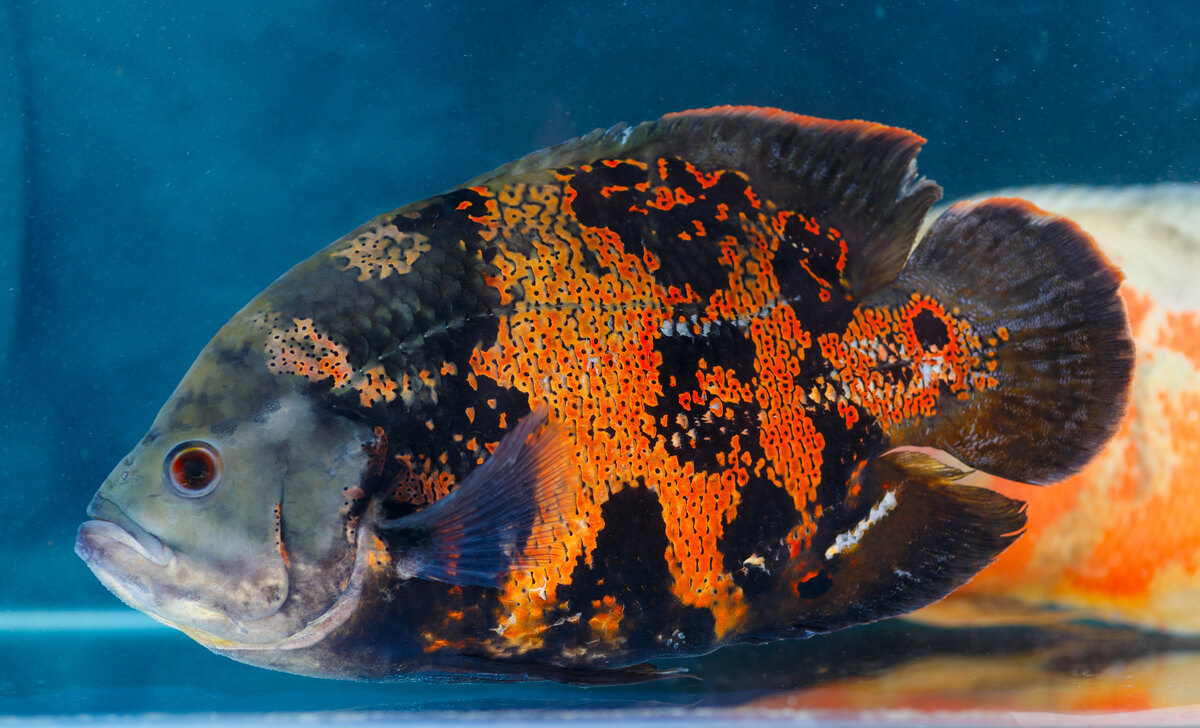
4. Betta fish (Betta splendens)
These fish are perhaps the best known, as they’re usually the first choice when you want to start an aquarium. Although it may seem contradictory, they aren’t the best recommendation to share a tank with several specimens. This is because betta fish are very territorial and aren’t afraid to fight constantly to defend their territory.
In fact, in Thailand, they’re often bred to carry out fights between two specimens, so they’re even known as Siamese fighting fish. This is just one example of how they react to other animals, which makes them incompatible with almost every type of fish. If you still want to keep them in your tank, consider choosing only females and avoid the following companions at all costs.
- Cichlids
- Tiger barbel
- Goldfish
- Rainbow fish
- Betta fish (males)
- Discus fish
- Guppies
- Neon fish
- Oscar fish
- Ramirezi fish
- Tetra fish
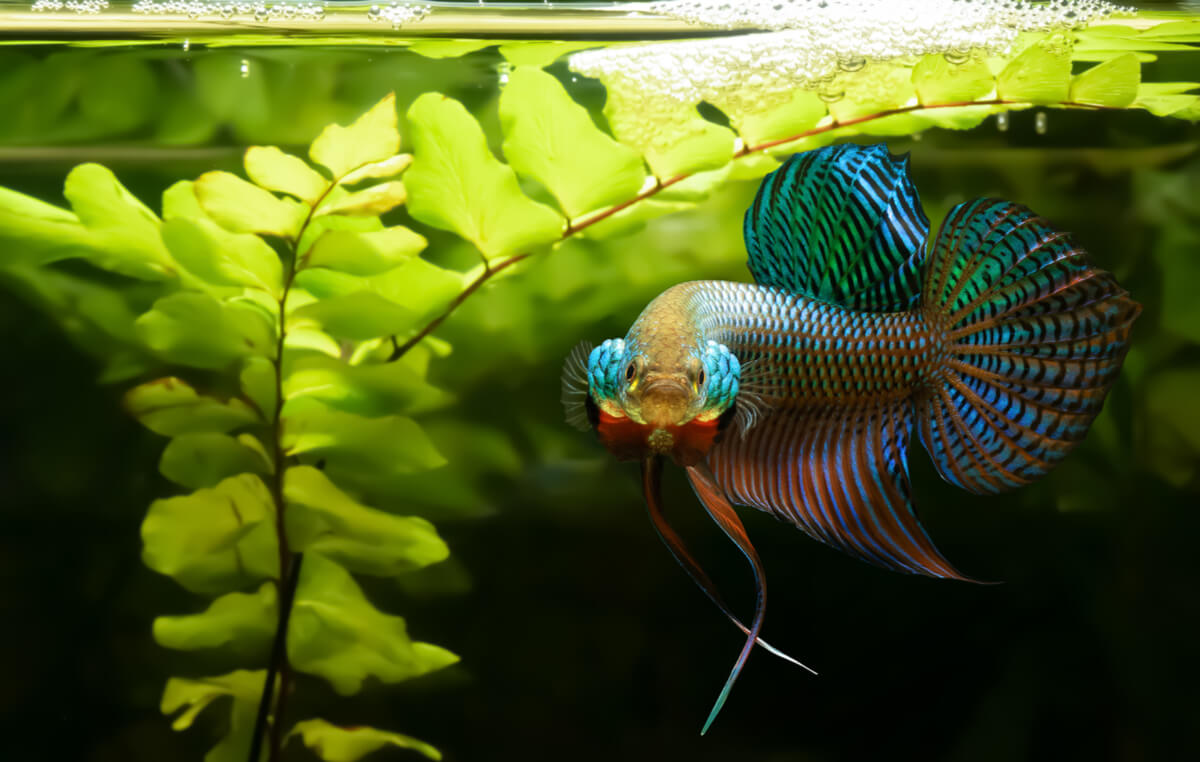
5. Cichlasoma
This peculiar fish stands out for its large head and its innate aggressiveness, and it’s a very unsociable fish for an aquarium. The reason behind the behavior of this specimen is unknown, as this variety is the product of the selective crossbreeding of various species of cichlids.
It’s almost impossible to keep the cichlasoma in a communal tank, as it’s necessary to have a lot of space and the right fish. For this reason, the best recommendation is to keep it in a separate tank, in which you only have one individual to avoid problems.
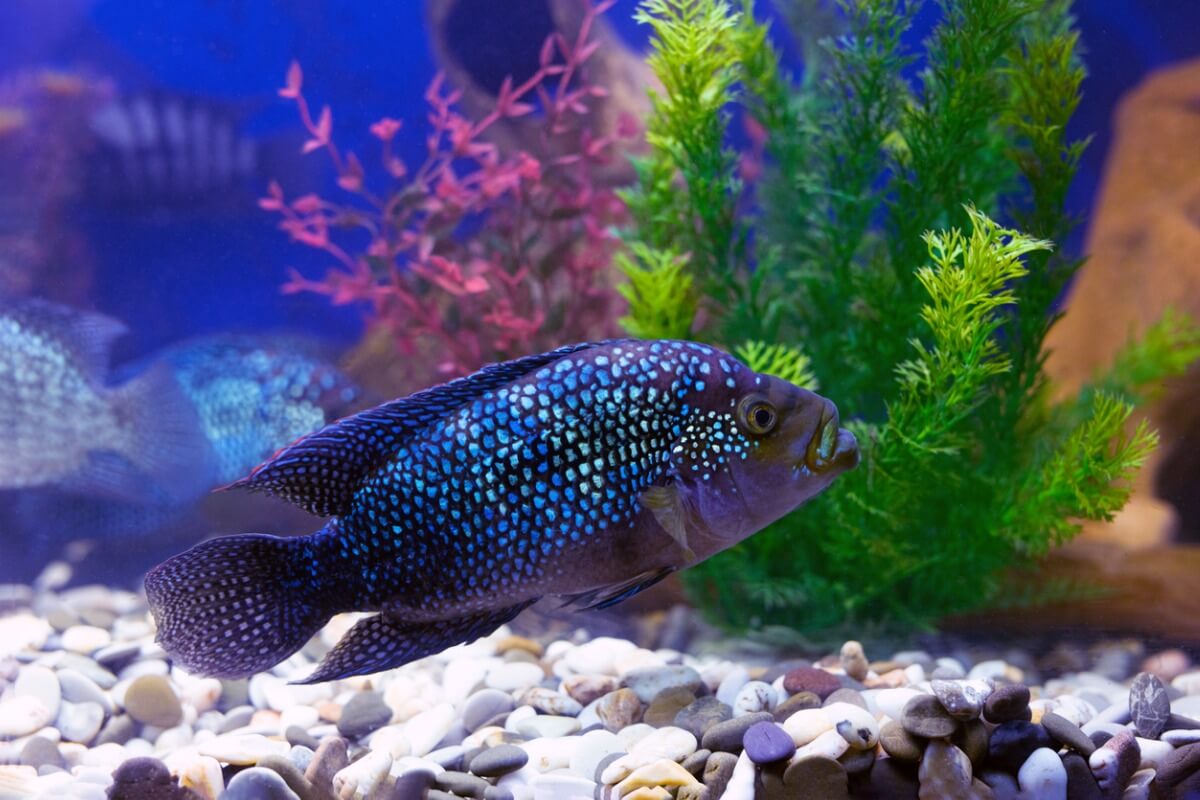
6. Bucktooth tetra (Exodon paradoxes)
This type of tetra is a rather beautiful fish, as it boasts transparent areas with bright spots. However, it’s one of the species with the worst reputation in the aquarium, as it’s very aggressive and actively attacks other specimens. For this reason, avoid it at all costs if you want to keep a peaceful aquarium.
These fish naturally form schools, so you need to keep them in an aquarium just for them and with at least 8 of them. If this isn’t done, the organisms run the risk of dying from their own aggressiveness, because when more individuals are present, the attacks are distributed among all of them. In short, no species coexists well with this tetra.

7. Red-tailed black shark (Epalzeorhynchos bicolor)
Although it has a rather striking color, this species of fish is solitary and very aggressive, as it chases with great speed any specimen that approaches it. However, these organisms are not a threat to the aquarium, as they don’t harm the fish they cohabit with
For this reason, it’s possible to keep them in a communal tank where they have enough space to shelter. The only requirement is to avoid territorial specimens that may compete with them, because even if they don’t harm each other it can be counterproductive. Some fish that should be avoided as companions of this fish are the following.
- Betta fish
- Cichlids
- Goldfish
- Oscar fish
- Discus fish
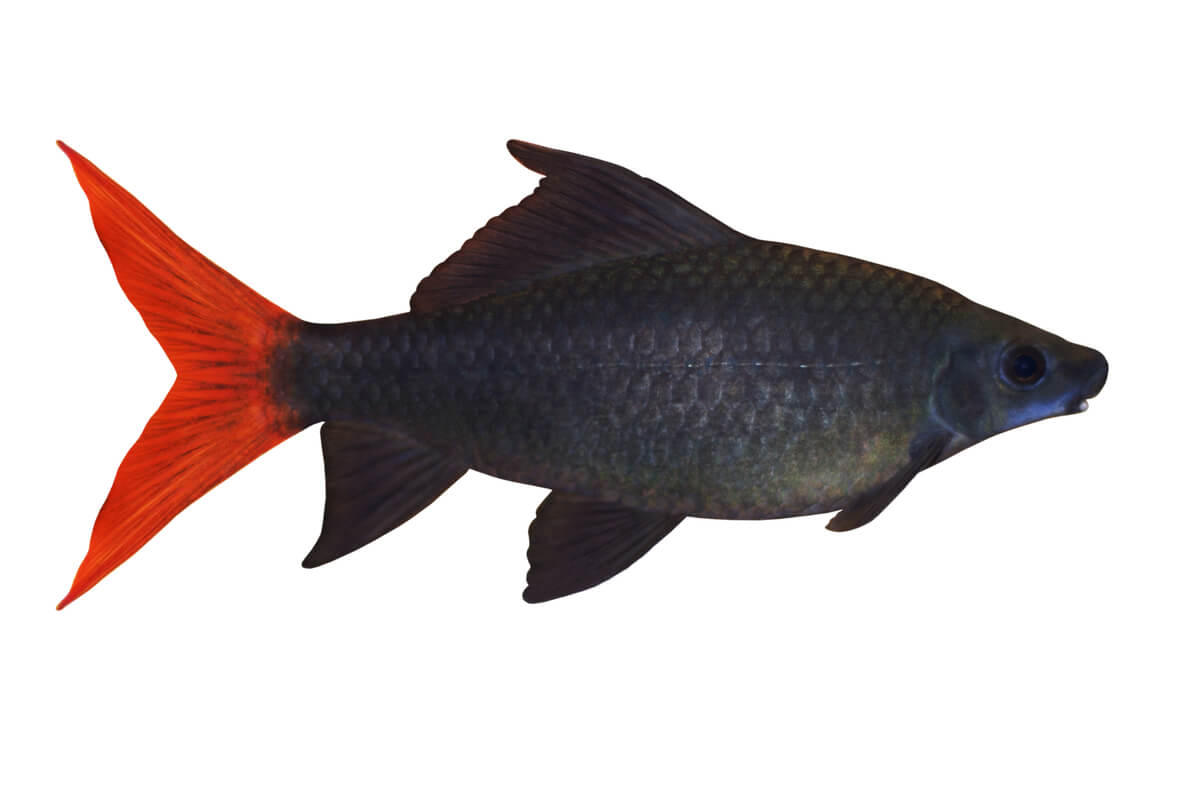
8. Piranhas
Piranhas are probably the most obvious fish for this list, as they are carnivorous species that enjoy devouring other fish. For this reason, they only live well with their conspecifics, although they’ll sometimes even attack each other. If you want to keep an aquarium with piranhas, it’s recommended not to keep any other type of fish.
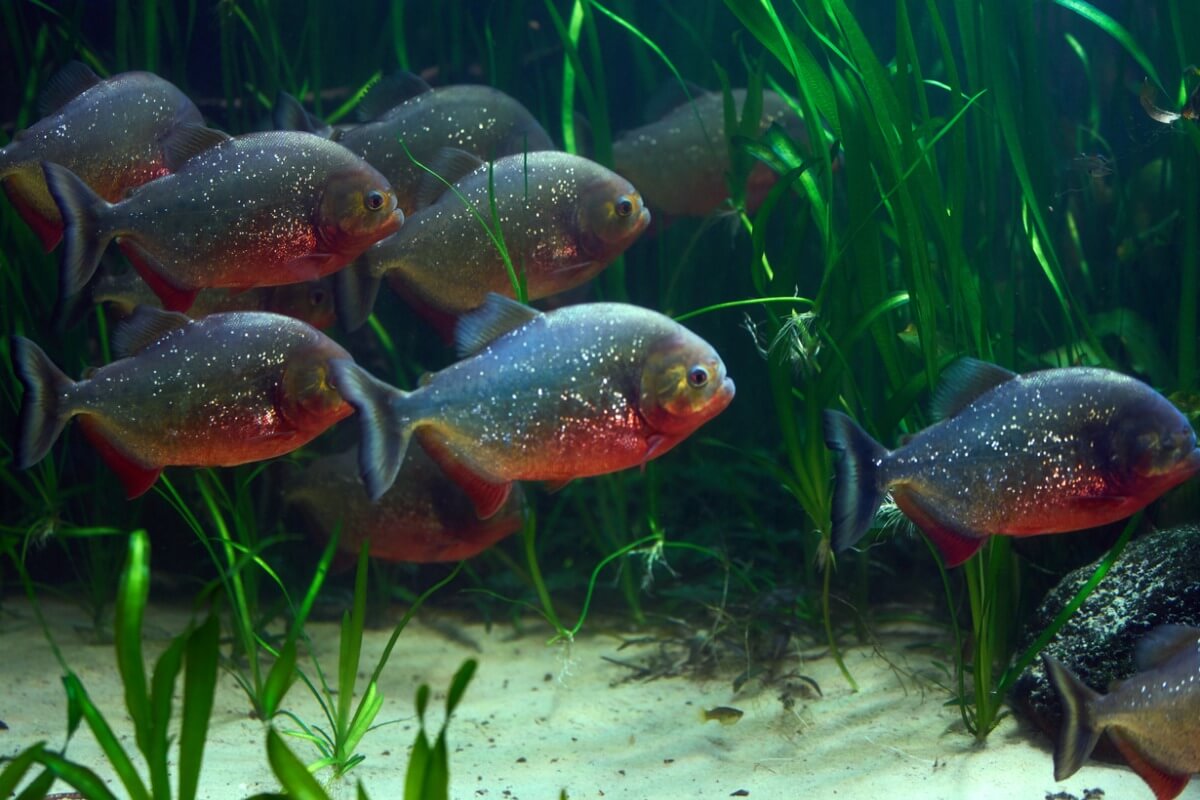
9. Grey bichir (Polypterus senegalus)
Among the most curious fish is the bichir, as its appearance is similar to that of eels. In addition, it prefers to live in the depths of the tank, where it will look for a shelter to hide. This fish is an active predator that consumes any other unwary specimen, so it won’t hesitate to feed on the smaller ones.
In general, the bichir fish is usually a quiet fish that doesn’t move from its hiding place. This means that, despite being aggressive, as long as the other fish respect its space it won’t have many problems inside the aquarium. In this sense, try to avoid placing it with to the following specimens.
- Guppies
- Betta fish
- Cichlids
- Neon fish
- Zebrafish
- Bichir fish (one per tank)
- Ramirezi fish
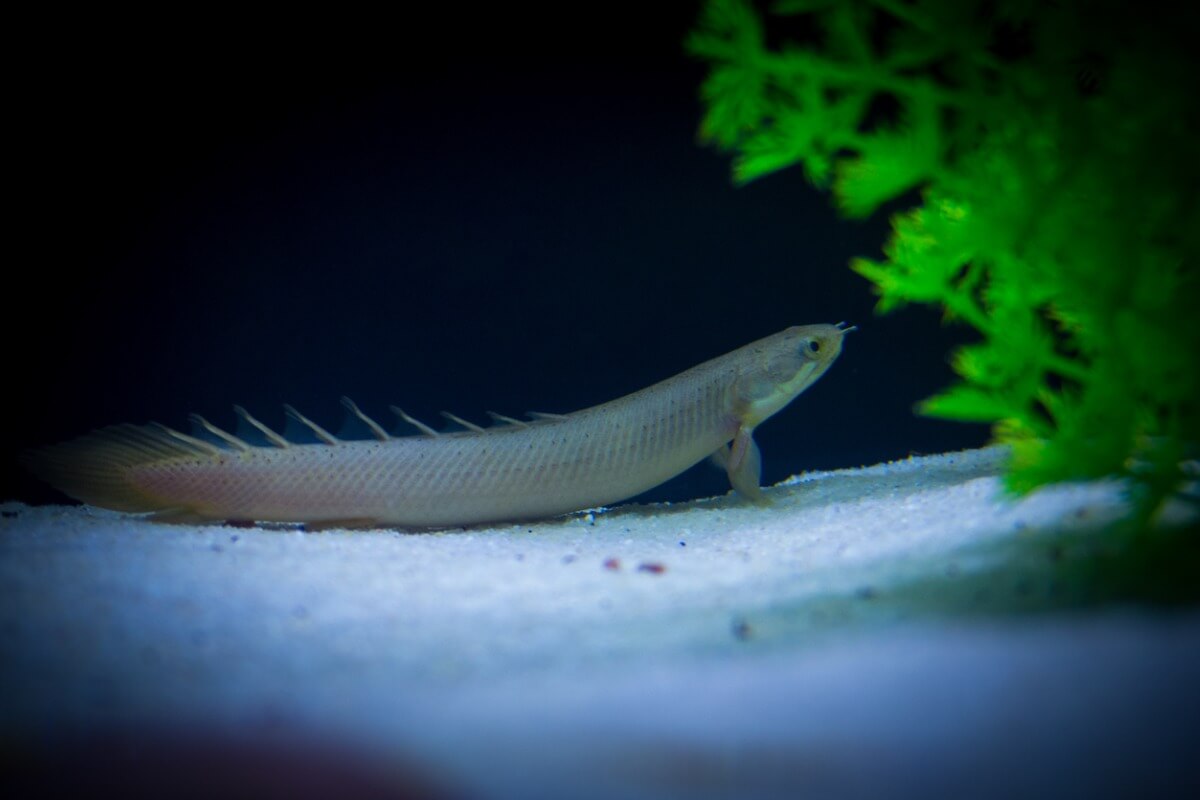
10. Silver arowana (Osteoglossum bicirrhosum)
In general, arowanas are difficult organisms to look after in an aquarium, because they become too large. In addition, they’re natural predators, so they’ll always keep after smaller species. Therefore, to keep them in a communal tank it’s best to avoid the following fish.
- Guppies
- Neon fish
- Zebrafish
- Platy fish
- Enderfishes
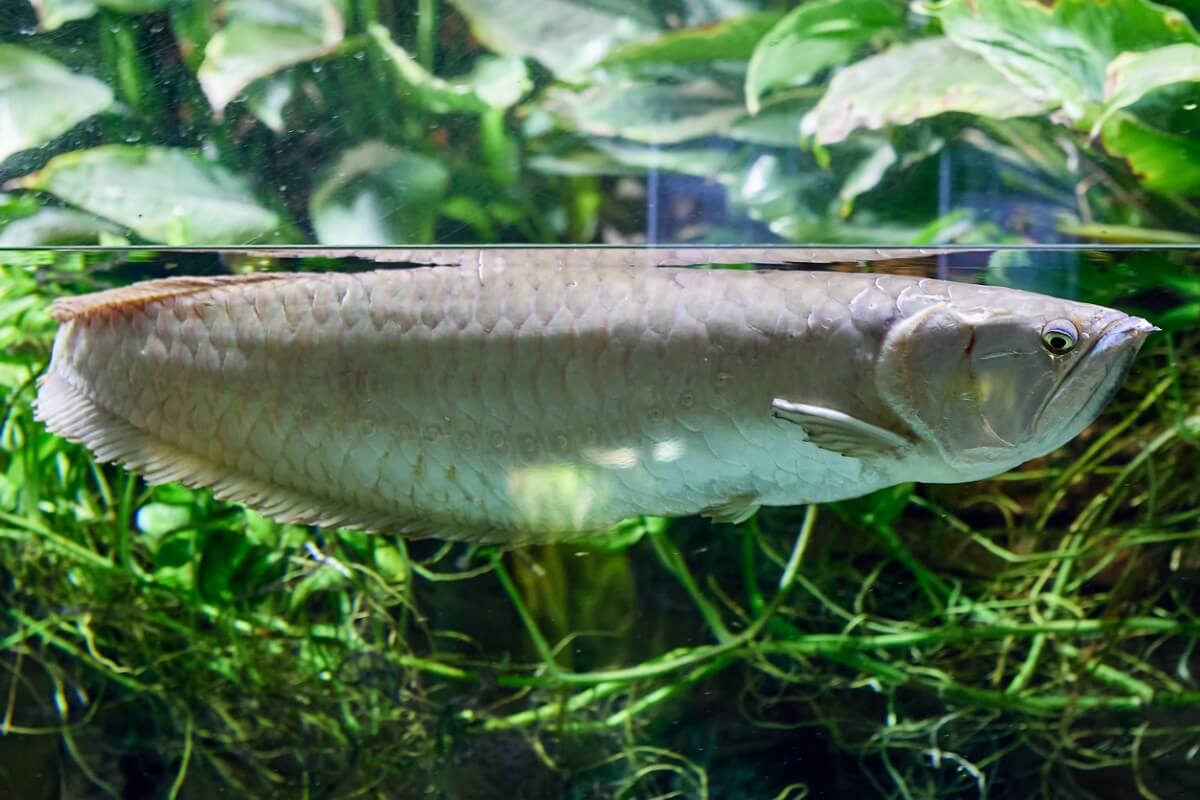
As you can see, not all species get along well with each other, as each has a different temperament. This means that any aquarium hobbyist should be careful when choosing the fish for their aquarium, as some can be overly aggressive. As with any other pet, remember to research their basic needs to keep them in excellent condition.
Aquariums are ideal for livening up our homes, and, even though they need continuous care, the bright colors of the specimens brighten up the room and the upkeep is always worth it. However, not all fish get along well inside the aquarium, as some tend to be more aggressive than others. Find out about 10 aggressive aquarium fish today.
It’s important to identify which species have the worst temperament. This way, conflicts are avoided and a calmer habitat is provided for all specimens. Read on to learn about 10 aggressive aquarium fish.
Why are fish aggressive?
In nature, fish don’t usually have enough food within their reach, and so they’re constantly searching for it. One of the most commonly used strategies is to monopolize a territory, since this means having more places to look for food. To protect their area of action, some fish have to be quite aggressive and chase away their competitors.
In this way, aggressiveness in fish is just a survival mechanism that allows them to grab resources. Violent behavior is also part of the life strategies of living beings, as it confers several advantages over other not so belligerent organisms.
Aggressive aquarium fish
Despite the fact that specimens live inside an aquarium, this doesn’t mean that they leave their wild instincts to one side. For this reason, some of them continue their aggressive behavior in the tank. This situation isn’t positive for the conditions of the tank, because, being a smaller space, the other members are easily stressed.
Here we’ll show you the most conflictive specimens in this type of environment.
1. African cichlids
One of the reasons for keeping an aquarium at home are the colors exhibited by the specimens. Therefore, it’s normal to look for fish such as African cichlids, as they have diverse and wonderful morphotypes. However, it’s better to be careful with them, as, apart from being very active organisms, some of them are territorial and quite aggressive.
This doesn’t mean that it’s impossible to have them in an aquarium, but it is difficult to find the ideal “aquarium mates”. In addition, it’s better if you provide them with a spacious habitat, so they can have more space to share with other fish. If their beauty has captivated you, consider that they aren’t compatible with the following types of fish.
- Angelfish
- Betta Fish
- Discus fish
- Goldfish
- Guppies
- Goldfish
- Rainbow fish
- Bubblefish
- Zebrafish
- Neon fish

2. Tiger barb (Puntius tetrazona)
Apart from being beautiful, these are very active and aggressive fish, as they sometimes chase the calmer species. This doesn’t mean that they’re territorial, as they’re usually sociable and tolerant fish. However, when the size of the aquarium is very small or there are many individuals in the tank, this fish suffers stress and begins to behave aggressively.
In general, it isn’t recommended to keep the tiger barbel with other slower or shy species, as it can annoy and injure them. Try not to add in the aquarium fish that meet these characteristics, as they’ll be the main targets. Some specimens with which tiger barbels aren’t compatible are listed below.
- Betta fish
- Goldfish
- Guppy fish
- Angelfish
- Discus fish
If you want to reduce the aggressive behavior of these fish, include more of their species. This calms their activity a bit and they will feel calmer, as barbs are gregarious by nature. This only reduces the intensity of the situation a little, so it isn’t a measure to prevent them from harming or eating others in the tank.
Not all aggressive aquarium fish are big.

3. Oscar fish (Astronotus ocellatus)
Despite the fact that Oscar fish tend to exhibit one of the most peculiar colorations, it’s important to know that they’re quite voracious. They simply cannot coexist with species that are smaller than them, since they won’t mind using them as food if they have the opportunity. This means that the problem isn’t that they’re territorial, but that they can eat any fish that enters their mouth.
A very good idea, if you want to have Oscar fish in an aquarium, is to only keep fish of this species. This will remove your worries regarding aggressiveness. If you’re still considering keeping several types of fish at the same time, the best recommendation is to avoid pairing them with the following.
- Angelfish
- Rainbow fish
- Betta fish
- Zebrafish
- Discus fish
- Dollar fish
- Goldfish
- Guppies
- Neon fish
- Platy fish
- Ramirezi fish
- Tetra fish

4. Betta fish (Betta splendens)
These fish are perhaps the best known, as they’re usually the first choice when you want to start an aquarium. Although it may seem contradictory, they aren’t the best recommendation to share a tank with several specimens. This is because betta fish are very territorial and aren’t afraid to fight constantly to defend their territory.
In fact, in Thailand, they’re often bred to carry out fights between two specimens, so they’re even known as Siamese fighting fish. This is just one example of how they react to other animals, which makes them incompatible with almost every type of fish. If you still want to keep them in your tank, consider choosing only females and avoid the following companions at all costs.
- Cichlids
- Tiger barbel
- Goldfish
- Rainbow fish
- Betta fish (males)
- Discus fish
- Guppies
- Neon fish
- Oscar fish
- Ramirezi fish
- Tetra fish

5. Cichlasoma
This peculiar fish stands out for its large head and its innate aggressiveness, and it’s a very unsociable fish for an aquarium. The reason behind the behavior of this specimen is unknown, as this variety is the product of the selective crossbreeding of various species of cichlids.
It’s almost impossible to keep the cichlasoma in a communal tank, as it’s necessary to have a lot of space and the right fish. For this reason, the best recommendation is to keep it in a separate tank, in which you only have one individual to avoid problems.

6. Bucktooth tetra (Exodon paradoxes)
This type of tetra is a rather beautiful fish, as it boasts transparent areas with bright spots. However, it’s one of the species with the worst reputation in the aquarium, as it’s very aggressive and actively attacks other specimens. For this reason, avoid it at all costs if you want to keep a peaceful aquarium.
These fish naturally form schools, so you need to keep them in an aquarium just for them and with at least 8 of them. If this isn’t done, the organisms run the risk of dying from their own aggressiveness, because when more individuals are present, the attacks are distributed among all of them. In short, no species coexists well with this tetra.

7. Red-tailed black shark (Epalzeorhynchos bicolor)
Although it has a rather striking color, this species of fish is solitary and very aggressive, as it chases with great speed any specimen that approaches it. However, these organisms are not a threat to the aquarium, as they don’t harm the fish they cohabit with
For this reason, it’s possible to keep them in a communal tank where they have enough space to shelter. The only requirement is to avoid territorial specimens that may compete with them, because even if they don’t harm each other it can be counterproductive. Some fish that should be avoided as companions of this fish are the following.
- Betta fish
- Cichlids
- Goldfish
- Oscar fish
- Discus fish

8. Piranhas
Piranhas are probably the most obvious fish for this list, as they are carnivorous species that enjoy devouring other fish. For this reason, they only live well with their conspecifics, although they’ll sometimes even attack each other. If you want to keep an aquarium with piranhas, it’s recommended not to keep any other type of fish.

9. Grey bichir (Polypterus senegalus)
Among the most curious fish is the bichir, as its appearance is similar to that of eels. In addition, it prefers to live in the depths of the tank, where it will look for a shelter to hide. This fish is an active predator that consumes any other unwary specimen, so it won’t hesitate to feed on the smaller ones.
In general, the bichir fish is usually a quiet fish that doesn’t move from its hiding place. This means that, despite being aggressive, as long as the other fish respect its space it won’t have many problems inside the aquarium. In this sense, try to avoid placing it with to the following specimens.
- Guppies
- Betta fish
- Cichlids
- Neon fish
- Zebrafish
- Bichir fish (one per tank)
- Ramirezi fish

10. Silver arowana (Osteoglossum bicirrhosum)
In general, arowanas are difficult organisms to look after in an aquarium, because they become too large. In addition, they’re natural predators, so they’ll always keep after smaller species. Therefore, to keep them in a communal tank it’s best to avoid the following fish.
- Guppies
- Neon fish
- Zebrafish
- Platy fish
- Enderfishes

As you can see, not all species get along well with each other, as each has a different temperament. This means that any aquarium hobbyist should be careful when choosing the fish for their aquarium, as some can be overly aggressive. As with any other pet, remember to research their basic needs to keep them in excellent condition.
All cited sources were thoroughly reviewed by our team to ensure their quality, reliability, currency, and validity. The bibliography of this article was considered reliable and of academic or scientific accuracy.
- Mohammadi, M., & Jafari, S. (2014). An expert system for recommending suitable ornamental fish addition to an aquarium based on aquarium condition. arXiv preprint arXiv:1405.1524.
- Monvises, A., Nuangsaeng, B., Sriwattanarothai, N., & Panijpan, B. (2009). The Siamese fighting fish: well-known generally but little-known scientifically. ScienceAsia, 35(1), 8-16.
- Huntingford, F., Tamilselvan, P., & Jenjan, H. (2012). Why do some fish fight more than others?. Physiological and Biochemical Zoology, 85(6), 585-593.
- Torgersen, T. (2020). Ornamental Fish and Aquaria. In The Welfare of Fish (pp. 363-373). Springer, Cham.
- Brandão, M. L., Dorigão‐Guimarães, F., Bolognesi, M. C., dos Santos Gauy, A. C., Pereira, A. V. S., Vian, L., … & Gonçalves‐de‐Freitas, E. (2021). Understanding behaviour to improve the welfare of an ornamental fish. Journal of Fish Biology.
This text is provided for informational purposes only and does not replace consultation with a professional. If in doubt, consult your specialist.








